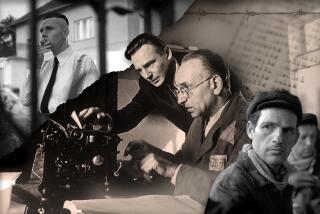Would They Have Made ‘Schindler’ for 2 Mil--and in Color?
Call it the “Schindler’s List” that almost was. And some say thank God it wasn’t.
Before Steven Spielberg’s ambitious three-hour, 13-minute, black-and-white epic of the Holocaust unfurled on the silver screen, low-budget movie company Cannon Pictures supposedly planned to make a $2-million version in the late ‘80s.
“One can only imagine what the Cannon movie would have been like under a $2-million budget,” said a former top Cannon executive who worked for the company’s co-founder, Yoram Globus, at the time. (Spielberg’s picture cost around $23 million and was shot in Poland.)
“Cannon is the (independent producer) who brought you ‘The Happy Hooker Goes to Hollywood,’ ‘Death Wish III,’ ‘Texas Chainsaw Massacre II’ and all of those ‘Delta Force’ movies. The people who ran Cannon, especially in the early days, were considered the schlockmeisters of the film business,” the executive added. “Thank God, Ladd (Alan Ladd Jr., then head of Cannon parent Pathe Communications) spotted it and killed it before it ever got made. We could have lost one of the best pictures of the last decade.”
(Spielberg and his critically acclaimed film are favored to win best director and best picture Oscars this year.)
But Globus, a proud Israeli, claims that he never worked on any Schindler project and doesn’t recall one ever being on Cannon’s slate.
Those who worked for Globus and his cousin, Menahem Golan, back when they both ran Cannon, say they made movies of such prominent properties as “The Three Penny Opera,” “A Cry in the Dark” and several Agatha Christie works, so it wasn’t surprising that they would pursue a Schindler story. (It likely would have been filmed in Israel, where most of their movies were made.)
Over the years, Cannon wasn’t the only one with designs on Schindler’s story.
Long before screenwriter Steven Zaillian’s script was ever delivered to Spielberg, “Casablanca” co-writer Howard Koch had penned a version in the early 1970s of Oskar Schindler’s life for MGM. Both the MGM script and aborted Cannon property (neither of which can be found) apparently centered on the focal point of Thomas Keneally’s tome “Schindler’s List”--Oskar Schindler, a womanizing German war profiteer and Nazi Party member who saved 1,300 Jews from the Nazi death camps in Poland by hiring them at his enamelware factory. It was MCA Inc./Universal President Sidney Sheinberg who bought Keneally’s book and sent it to Spielberg shortly after it was published in 1982.
And it was Alan Ladd Jr., now an independent producer at Paramount Pictures, who came across the Schindler project on Cannon’s future slate when he was at Pathe (which also for a brief time owned MGM). He immediately called Spielberg, a friend whom he knew had plans to do “Schindler’s List.”
“I knew this meant a lot to Steven,” said Ladd, recalling that Spielberg was pretty upset when he heard about Cannon’s plans.
In the early ‘70s, MGM had acquired rights to the Schindler story from his family’s estate and had a deal that if Keneally wrote the book, the studio would get first crack at a screen adaptation. MGM retained control of the estate rights but eventually passed on buying Keneally’s book. Even though MCA’s Sheinberg bought the book rights for Spielberg, Universal kept extending the option from MGM every year until the film was finally made.
And the rest, as they say, is movie history.
More to Read
Only good movies
Get the Indie Focus newsletter, Mark Olsen's weekly guide to the world of cinema.
You may occasionally receive promotional content from the Los Angeles Times.










